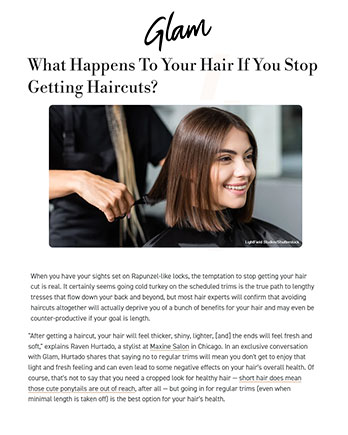Glam September 5, 2024
 Glam
Glam
Hair
What Happens To Your Hair If You Stop Getting Haircuts?
When you have your sights set on Rapunzel-like locks, the temptation to stop getting your hair cut is real. It certainly seems going cold turkey on the scheduled trims is the true path to lengthy tresses that flow down your back and beyond, but most hair experts will confirm that avoiding haircuts altogether will actually deprive you of a bunch of benefits for your hair and may even be counter-productive if your goal is length.
"After getting a haircut, your hair will feel thicker, shiny, lighter, [and] the ends will feel fresh and soft," explains Raven Hurtado, a stylist at Maxine Salon in Chicago. In an exclusive conversation with Glam, Hurtado shares that saying no to regular trims will mean you don't get to enjoy that light and fresh feeling and can even lead to some negative effects on your hair's overall health. Of course, that's not to say that you need a cropped look for healthy hair — short hair does mean those cute ponytails are out of reach, after all — but going in for regular trims (even when minimal length is taken off) is the best option for your hair's health.
The downsides of not cutting your hair
Many people love the feeling of leaving the salon after a cut, but bouncy, lightweight hair isn't the only reason to schedule in those regular trims. Raven Hurtado tells Glam exclusively that forgoing haircuts altogether increases your "chances of getting split ends" and can subsequently lead to the hair feeling "thin." Unfortunately, you can't repair split ends once they've formed (though you can improve their appearance), so the only way to prevent that split from traveling further up the hair shaft is to cut it off. If you don't, your hair will eventually feel much less full due to the fraying of your ends.
Additionally, Hurtado reveals that trims are important for aesthetic reasons, too, adding that "your hair will get long, lose shape, [and] hairstyles won't last as long" once you let it grow unattended. This is especially true for high-maintenance styles, such as blunt bangs inspired by the twee renaissance or cuts with shorter layers that depend on that short length for their volume and silhouette.
How often should you cut your hair?
You definitely need to get regular hair trims to avoid split ends and maintain your style, but what counts as regular? According to Raven Hurtado, six months of no cuts is all it takes for you to start noticing the negative impacts outlined above, so that's the absolute longest amount of time you should wait. "It'll feel unkept, and it'll feel that way [until] you get a regular trim," she shares exclusively with Glam.
The ideal time to wait before trimming varies from person to person, and several factors can influence this, including hair type, hair damage, environmental elements, and hairstyle. Short hair generally requires a trim every six weeks to keep up its shape, while you can push it out to 12 weeks if your hair is long (or you're trying to grow it out). However, if your hair is damaged, you may need a trim sooner, so don't hesitate to talk with your stylist about any concerns.
